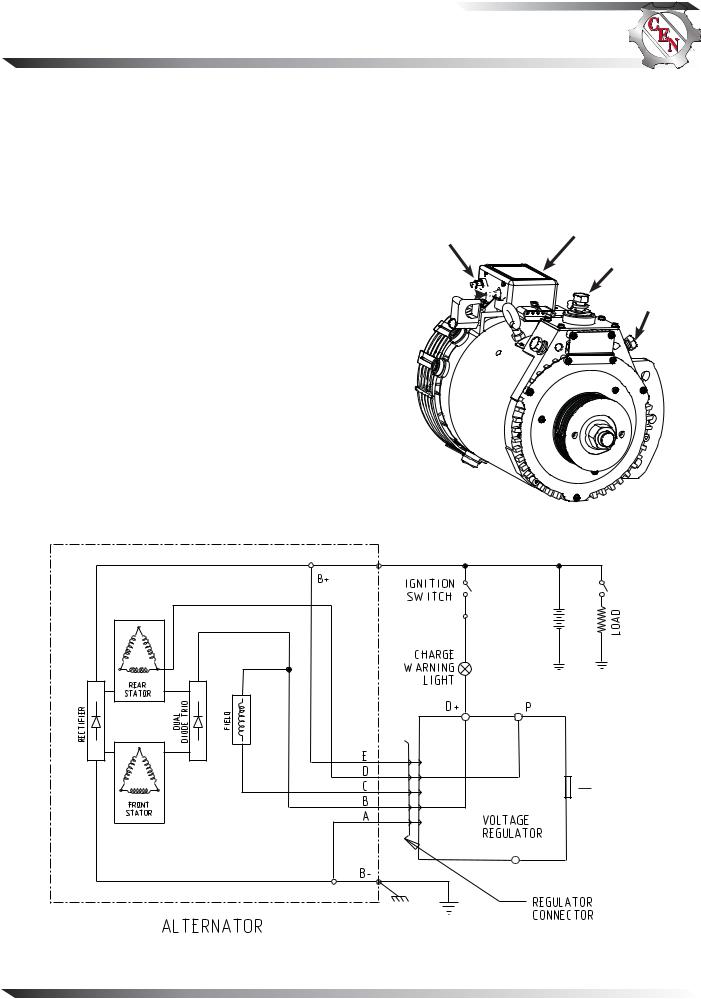C.E. Niehoff & Co. C626 Troubleshooting Guides

C.E. Niehoff & Co.
Hazard Definitions
These terms are used to bring attention to presence of hazards of various risk levels or to important information concerning product life.
CAUTION
NOTICE
Indicates presence of hazards that will or can cause minor personal injury or property damage.
Indicates special instructions on installation, operation or maintenance that are important but not related to personal injury hazards.
Table of Contents |
|
Section A: Wiring Diagram ....................................... |
2 |
Section B: Basic Troubleshooting............................. |
3 |
Section C: Advanced Troubleshooting ................ |
4 – 5 |
Battery Conditions
Until temperatures of electrical NOTICE system components stabilize, these
conditions may be observed during cold-start voltage tests.
•Maintenance/Low Maintenance Battery
—Immediately after engine starts, system volts are lower than regulator setpoint, amps are medium.
—3–5 minutes into charge cycle, system volts increase, amps decrease.
—5–10 minutes into charge cycle, system volts increase to, or near, regulator setpoint and amps decrease to a minimum.
—Low maintenance battery has same characteristics with slightly longer recharge times.
•Maintenance-free Battery
—Immediately after engine starts, system volts are lower than regulator setpoint, low charging amps.
—Once charge cycle begins, low volts and low amps are still present.
—After alternator energizes, voltage will increase several tenths. Amps will increase gradually, then quickly, to medium to high amps.
—Finally, volts will increase to setpoint and amps will decrease.
The time it takes to reach optimum voltage and amperage will vary with engine speed, load, and ambient temperature.
•High-cycle Maintenance-free Battery
These batteries respond better than standard mainte- nance-free. Charge acceptance of these batteries may display characteristics similar to maintenance batteries.
•AGM (Absorbed Glass Mat) Maintenance-free Battery
These dry-cell batteries respond better than standard maintenance-free. If battery state of charge drops to 75% or less, batteries should be recharged to 95% or higher separately from the engine’s charging system to avoid damaging charging system components and to provide best overall performance. Charge acceptance of these batteries may display characteristics similar to maintenance batteries.
C626 Alternator
Troubleshooting Guide
Battery Charge Volt and Amp Values
Volt and amp levels fluctuate depending on the battery state of charge. If batteries are in a state of discharge—as after extended cranking time to start the engine—system volts will measure lower than the regulator setpoint after the engine is restarted and system amps will measure higher. This is a normal condition for the charging system; the greater the battery discharge level, the lower the system volts and the higher the system amps. The volt and amp readings will change as batteries recover and become fully charged: system volts will increase to regulator setpoint and system amps will decrease to low level (depending on other loads).
•Low Amps: Minimum or lowest charging system amp value required to maintain battery state of charge, obtained when testing the charging system with a fully charged battery and no other loads applied. This value will vary with battery type.
•Medium Amps: System amps value which can cause the battery temperature to rise above adequate charging temperature within 4-8 hours of charge time. To prevent battery damage, the charge amps should be reduced when battery temperature rises. Check battery manufacturer’s recommendations for proper charge amp rates.
•High Amps: System amps value which can cause
the battery temperature to rise above adequate charging temperature within 2-3 hours of charge time. To prevent battery damage, the charge amps should be reduced when battery temperature rises. Check battery manufacturer’s recommendations for proper charge amp rates.
•Battery Voltage: Steady-state voltage value as measured with battery in open circuit with no battery load. This value relates to battery state of charge.
•Charge Voltage: Voltage value obtained when the charging system is operating. This value will be higher than battery voltage and must never exceed the regulator voltage setpoint.
•B+ Voltage: Voltage value obtained when measuring voltage at battery positive terminal or alternator B+ terminal.
•Surface Charge: Higher than normal battery voltage occurring when the battery is disconnected from battery charger. The surface charge must be removed to determine true battery voltage and state of charge.
•Significant Magnetism: Change in strength or intensity of a magnetic field present in alternator rotor shaft when the field coil is energized. The magnetic field strength when the field coil is energized should feel stronger than when the field is not energized.
•Voltage Droop or Sag: Normal condition occurring when the load demand on alternator is greater than rated alternator output at given rotor shaft RPM.
TG67B |
Page 1 |

Section A: Wiring Diagrams
CEN C626 Alternators Description and Operation
C626 28 V (260 A) alternator is self-rectifying and selfenergized. All windings and current-transmitting components are non-moving, so there are no brushes or slip rings to wear out.
When controlled by the A2-337 regulator, the alternator becomes self-energized through sensing of alternator rotation through AC circuit. Residual magnetic field induces small voltage in stator and energizes field coil. Field coil continues receiving incremental voltage until full voltage is achieved. Regulator controls voltage output. See wiring diagram, Figure 2. A2-337 regulator has:
•P terminal that can provide optional AC voltage tap.
•D+ terminal that can provide DC voltage signal to vehicle electrical system, confirming alternator operation.
•Tricolored LED. See page 4.
•T terminal to connect optional A9-4011 temperature sense lead to adjust regulator setpoint to maintain charge voltage (or negative temperature compensation) by sensing ambient temperature within the battery box. If temperature sense lead is not connected, regulator uses setpoint switch on the back of the regulator to keep a constant setpoint
(or flat temperature compensation).
When controlled by the A2-141 regulator, this alternator becomes self-energizing through internal diode trios. Residual magnetic field induces small voltage in stator
and energizes field coil. Field coil continues receiving incremental voltage until full voltage is achieved. AC is rectified into DC output through diodes. Regulator controls voltage output. Regulator has:
•D+ terminal to provide a signal to vehicle electrical system, confirming alternator operation
•P terminal to provide an optional AC voltage tap.
T terminal
P (A2-337 only) terminal
B+ terminal
D+ terminal 








B– terminal
Figure 1 — C626 AlternatorTerminals
T
(A2-337 only)
LED
(A2-337 only)
Figure 2 — C626 Alternator with A2-141 or A2-337 Regulator
Page 2 |
TG67B |
